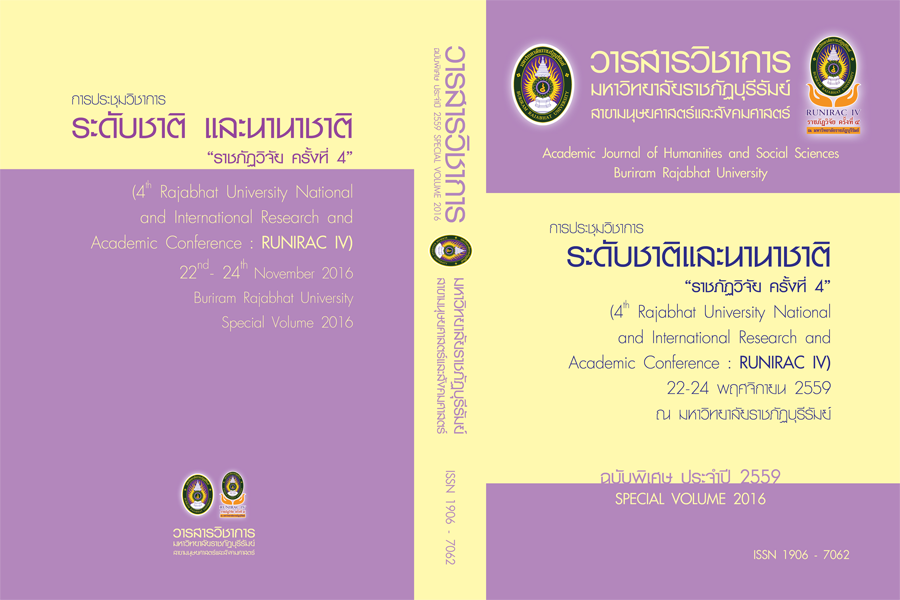“Shan Cuisine” The Intangible Cultural Heritage of Shan Cuisine along the Thai Frontier
Main Article Content
บทคัดย่อ
การวิจัยนี้มีวัตถุประสงค์เพื่อศึกษาและรวบรวมอัตลักษณ์ด้านอาหารของกลุ่มชาติพันธุ์ไท
ใหญ่ ในฐานะเป็นมรดกภูมิปัญญาทางวัฒนธรรมของกลุ่มชาติพันธุ์ เพื่อเตรียมการฐานข้อมูลสำ หรับ
นำ เข้าสู่กระบวนการจัดทำ บัญชีรายการมรดกภูมิปัญญาทางวัฒนธรรม “ครัวไทใหญ่” ประเทศไทย
ต่อไป
งานวิจัยชิ้นนี้เป็นงานวิจัยเชิงคุณภาพที่เก็บข้อมูลภาคสนามด้วยการประเมินชุมชนแบบเร่ง
ด่วนเชิงชาติพันธุ์วรรณนา(RECAP)ร่วมกับการวิจัยเชิงชาติพันธุ์วรรณนา(EthnographyResearch)
และการวิจัยเชิงสำรวจ(SurveyResearch) เครื่องมือวิจัยที่ใช้ประกอบด้วยแบบบันทึกรายการมรดก
ภูมิปัญญาทางวัฒนธรรม แบบสัมภาษณ์ทั้งที่มีโครงสร้างและไม่มีโครงสร้างและเครื่องมือศึกษาชุมชน
7ด้าน ประชากรที่ใช้ในการศึกษาเป็นปราชญ์ด้านภูมิปัญญาอาหารผู้มีอาชีพขายอาหารไทใหญ่และ
พ่อครัว/แม่ครัวกรณีมีงานพิธีของชุมชนไทใหญ่จังหวัดเชียงราย เชียงใหม่ แม่ฮ่องสอนและตาก โดย
เทคนิคการเลือกตัวอย่างแบบลูกโซ่ (Snowball Sampling)
ผลการศึกษาและรวบรวมอัตลักษณ์ด้านอาหารของกลุ่มชาติพันธุ์ไทใหญ่นำ เสนอในแบบ
รายการ ภายใต้บทบาทหน้าที่ซึ่งสัมพันธ์กันระหว่าง (1) การเป็นสูตรอาหาร (2) การเป็นอัตลักษณ์
(3) การเป็น (อาหาร) ชาติพันธุ์(4) การเป็นภูมิปัญญา (5) การมีคุณค่าทางวัฒนธรรม และ (6) การ
สะท้อนบริบทชุมชน
ผลการศึกษา“ครัวไทใหญ่” ทั้ง ๔ พื้นที่มีอัตลักษณ์ร่วมคือเครื่องปรุงหลักสามชนิดได้แก่ถั่ว
เน่า มะเขือเทศและงา หากแต่แต่ละพื้นที่มีวิธีการปรุงแตกต่างกันไปตามการกลืนกลายทางวัฒนธรรม
กับกลุ่มชาติพันธุ์ที่ปฏิสัมพันธ์ด้วยควบคู่ไปกับการปรับเปลี่ยนไปตามบริบทชุมชนด้านต่างๆเครื่องปรุง
หลักทั้งสามจึงเป็นอัตลักษณ์ร่วมที่นำ มาซึ่งความรู้สึกเป็นพวกเดียวกัน (Self-Ascription)ของไทใหญ่
ในขณะที่อีกด้านหนึ่งคือการแบ่ง “ตัวเอง” ออกจาก “คนอื่น” (Ascribe by Others) ที่เป็นไทใหญ่
จากต่างภูมิภาครวมถึงกลุ่มชาติพันธุ์อื่นด้วย นั่นแสดงว่า “ครัวไทใหญ่” หมายถึงสิ่งที่ทั้ง “เรา” และ
“คนอื่น” รู้สึกว่าเป็น “อัตลักษณ์ด้านอาหาร” นั่นเอง
นอกจากนี้“ครัวไทใหญ่” ยังเป็นสิ่งบ่งบอกความเป็น (อาหาร) ชาติพันธุ์ที่ใช้ในการสร้าง
พื้นที่และสำ นึกทางชาติพันธุ์ไทใหญ่ให้เกิดขึ้นในประเทศไทย รวมไปถึงการเป็น “พื้นที่แห่งการเชื้อ
เชิญ” (space of inclusion) ให้“คนนอก” (กลุ่มชาติพันธุ์) มา “ศึกษา/เรียนรู้/ชิม” อาหาร “คน
อื่น” (ไทใหญ่) อีกด้วย
บันทึกมรดก ฯ รวมทั้งสิ้น 44 รายการ ประกอบด้วยอาหารคาว 33 รายการ และอาหารหวาน 11
Article Details
- ต้นฉบับที่ได้รับการตีพิมพ์ในวารสารวิชาการ มหาวิทยาลัยราชภัฏบุรีรัมย์ สาขามนุษยศาสตร์และสังคมศาสตร์ ถือเป็นกรรมสิทธิ์ของมหาวิทยาลัยราชภัฏบุรีรัมย์ ห้ามนำข้อความทั้งหมดหรือบางส่วนไปพิมพ์ซ้ำเว้นเสียแต่ว่าจะได้รับอนุญาตจากมหาวิทยาลัยฯ เป็นลายลักษณ์อักษร
- เนื้อหาต้นฉบับที่ปรากฏในวารสารเป็นความรับผิดชอบของผู้เขียน ทั้งนี้ไม่รวมความผิดพลาด อันเกิดจากเทคนิคการพิมพ์
เอกสารอ้างอิง
DoreanWeightman, Tr.London : J.Cape.
Department of Cultural Promotion. (2015). The proposed guide for registration
of National Intangible Cultural Heritage. Bangkok: Office of security service
of The War Veterans Organization of Thailand Under Royal Patronage of His
Majesty the King Printery.
Fuengfuskul, A. (2003). Identity: A review of thetheoreticaland conceptual framework.
Bangkok: Board of the National Research Council National Research Council.
Intangible Cultural Heritage.Categories of intangible cultural heritage. Retrieved
December23,2015, formhttp://ichculture.go.th/index.Php/th/ich/categories.
Juengsathiansub, K. (2002). Communities Learning Guide:Thefriendly community
Effective and Fun.Bangkok: Health Systems Research Institute.
Keawdev, K. (2010). Management of cultural innovation with participatory research.
Chiang Mai : Global Vision.
Kongsuwan, D., Treeagarnukul, L., Phundhu, P., &Thiwong, S. (2016). Shan Cuisine :
the Intangible Cultural Heritageof Ethnic Group along Thai Frontier. Bangkok :
Department of Culture Promotion, Ministry of Culture.
Lertchavalitsakul, B. (2009). Shan ethnic food: the cultural politics of taste in Chiang
Mai City (Master Dissertation). Chiang Mai University, Chiang Mai.
Lieberman Ls. (1987). BioculturalConquences of Animals versus Plants as Sources
of Fats, Proteins, and other Nutrients. In Harris M and Ross E (Ed.), Food and
Evolution. (pp. 225-258). Philadelphia : Temple University Press.
Nonthabuth,K. (2013). Manual skills development researchcommunity withresearch,
ethnography urgent. Bangkok: Department of Health.
Piyaphimonsit, C. (2001). Sampling. Retrieved December 30, 2015,
from http://www. watpon.com/Elearning/res22.htm.
Podhisita, C. (2003). The Art and Science of Qualitative research. Bangkok : Amarin
Printing & Publishing.
Pradit, P. Advisory Council ofMae Hong Son. Interview. October 27, 2015.
Prasongbunthit,S. (2010).TheconceptofPierreBourdieu:Theanthropological theory.
Bangkok : Kled Thai.
Sunthornphasus,S. (1997). ContemporarySociologicalTheory. Chiang Mai: GlobalVision.
Survey research.Retrieved January 25, 2016, form http://hq.prd.go.th/plan/ewt_dl_
link.php?Nid= 2284


